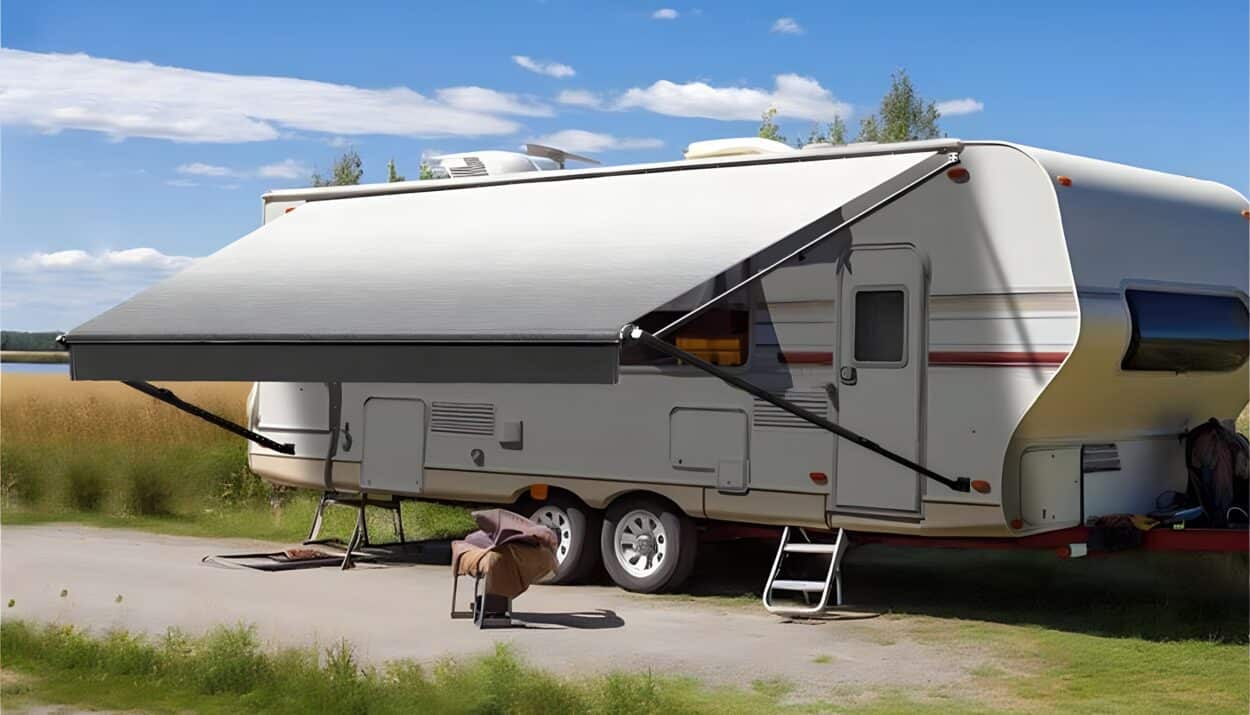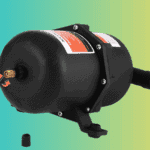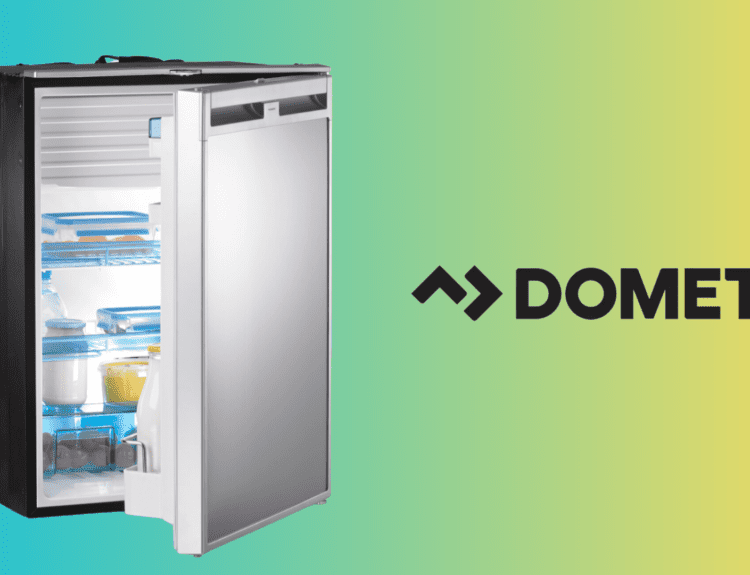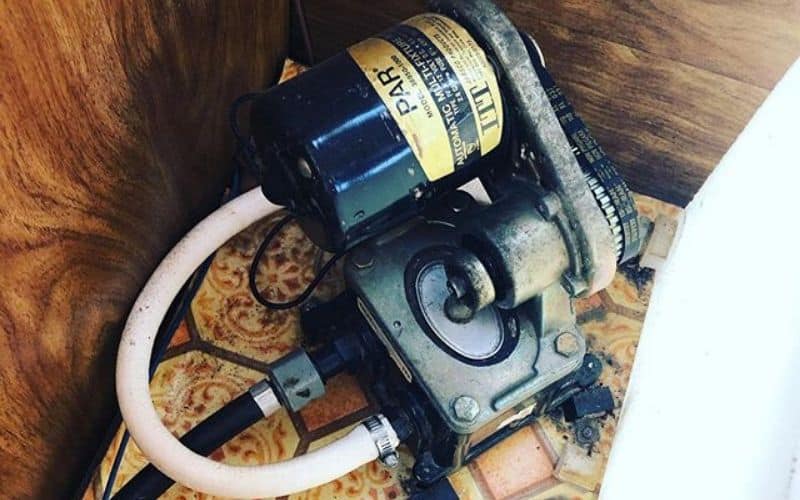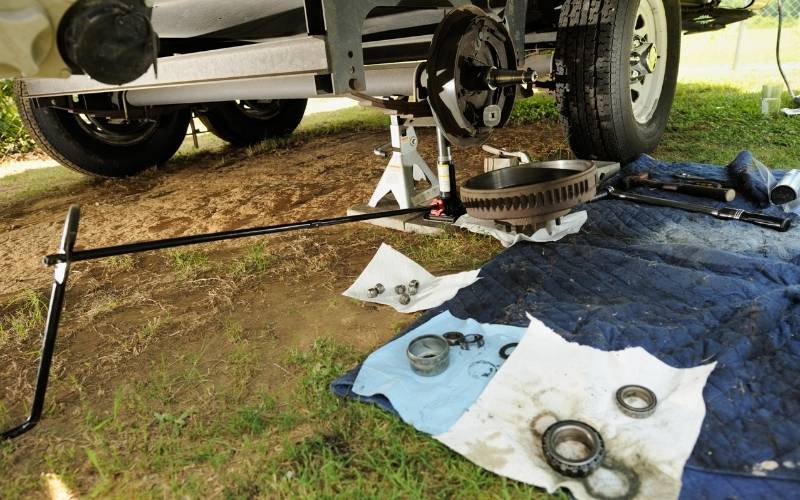RV awnings primarily come in two fabric types – vinyl and acrylic. Vinyl is fairly resilient to dust and damage, so you can clean it with basic soap and water. Acrylic canvas is a bit trickier. It needs special care to prevent the waterproof coating from breaking down over time.
RVs are for adventure—from winding mountain roads to seaside campsites, your home on wheels can take you places. Your RV awning is especially vulnerable as it faces the brunt of mud, dust, rain, and road debris. That’s why properly cleaning and caring for your RV awning is critical.
As a long-time RVer, I’ve made many mistakes caring for awnings. I’ve learned firsthand what works and what doesn’t! In this guide, I’ll share step-by-step instructions, pro tips, and answers to some FAQs on how to clean an RV awning.
Cleaning The RV Awning: Simple DIY steps
Cleaning an RV awning regularly is important to keep it looking fresh, prevent mold and mildew growth, and prolong its lifespan. Now, let’s get into the nitty-gritty of how to clean an RV awning with these ten steps:
Choose The Right Time And Weather Conditions
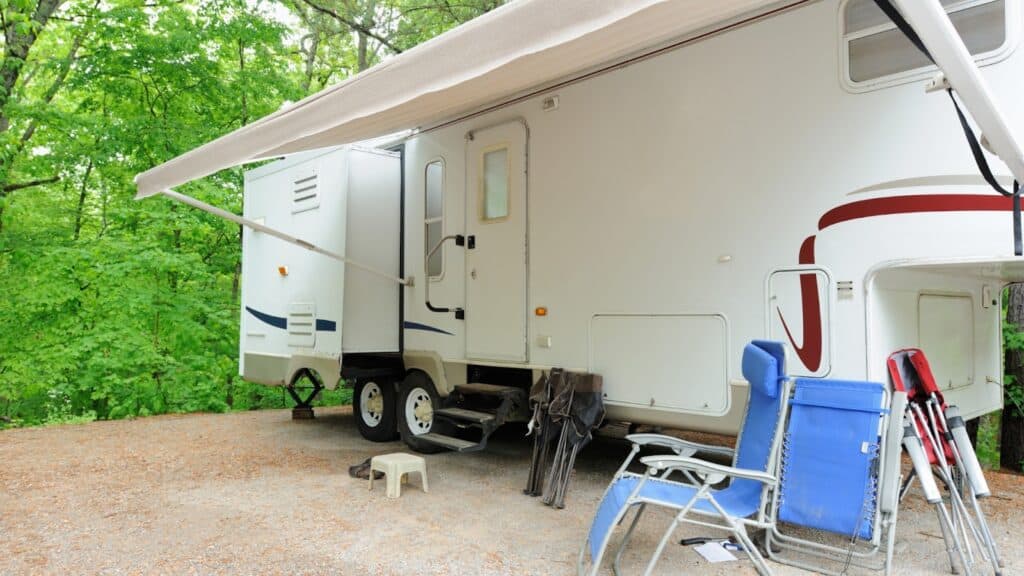
It’s best to clean your RV awning when it’s not in direct sunlight. The ideal time is early morning or late evening when sunlight is less intense. You can also clean on overcast or cloudy days. Avoid cleaning when it’s hot and sunny, as this can leave chemical residue that is hard to rinse.
Prepare A Cleaning Solution

Mix a cleaning solution of one-quarter cup of dish soap diluted in five gallons of water. Use a mild detergent like Dawn or any other RV-approved cleaner. Alternatively, make a cleaning solution using one cup of white vinegar and one-quarter cup of dish soap mixed with one gallon of water. The vinegar helps brighten the fabric.
Brush Off Loose Dirt
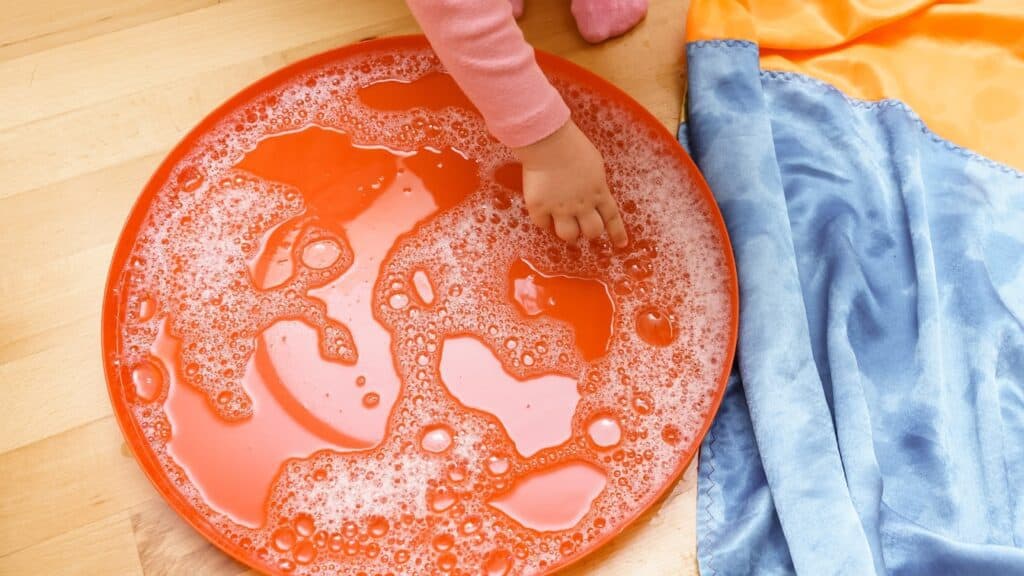
Use a soft bristle brush broom to gently sweep off any loose dirt, leaves, bird droppings, or other debris from the top and bottom of the awning fabric before wetting it. This removes grit that could cause abrasion damage during scrubbing.
Apply The Cleaning Solution
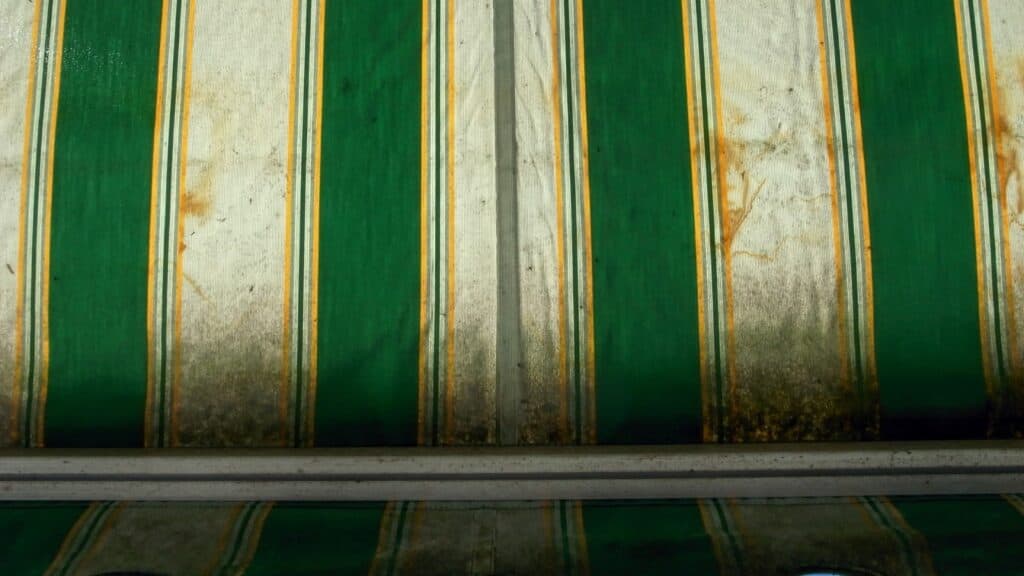
Use a sponge, soft brush, or cleaning wand to liberally apply the diluted cleaner over the entire awning fabric surface. Ensure you cover all areas of the fabric, letting the solution soak into dirty spots and stains.
Let The Solution Sit
Allow the cleaning solution to sit on the awning 10-15 minutes after application. This gives the detergent time to start breaking down dirt, mold, mildew, and stains so you can easily remove them with scrubbing. This is one of the crucial aspects of how to clean an RV awning effectively.
Scrub The Awning
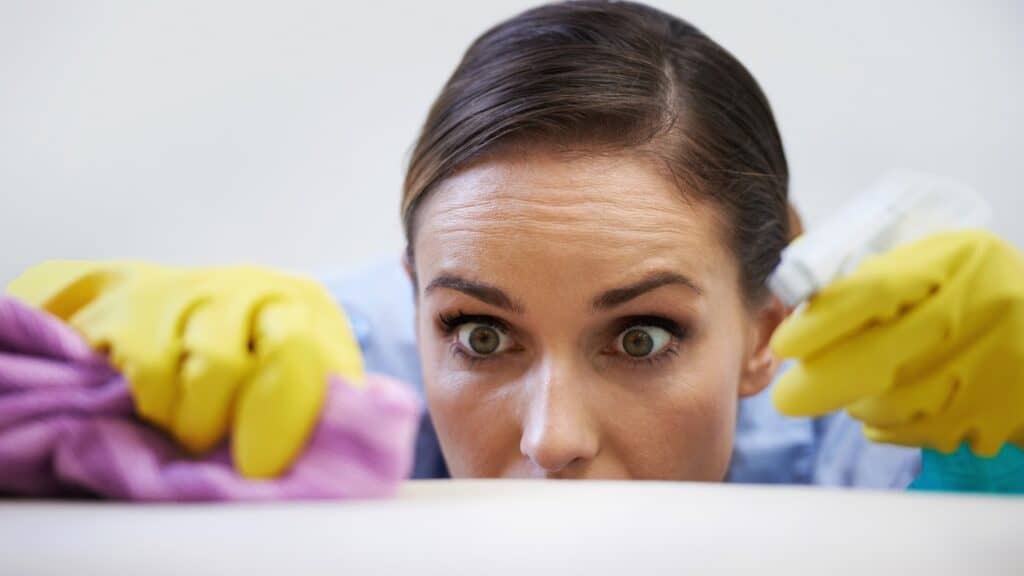
Use a soft bristle scrub brush or sponge to gently scrub the entire awning surface to lift dirt and stains. Apply light pressure to avoid damaging the fabric. Focus on heavily soiled areas first.
Rinse The Awning
Thoroughly rinse the entire awning using clean water from a hose or bucket to remove all detergent residue. You may need to rinse several times until the water runs clear. If any soap residue remains, it can dry and form stains.
Dry The Awning
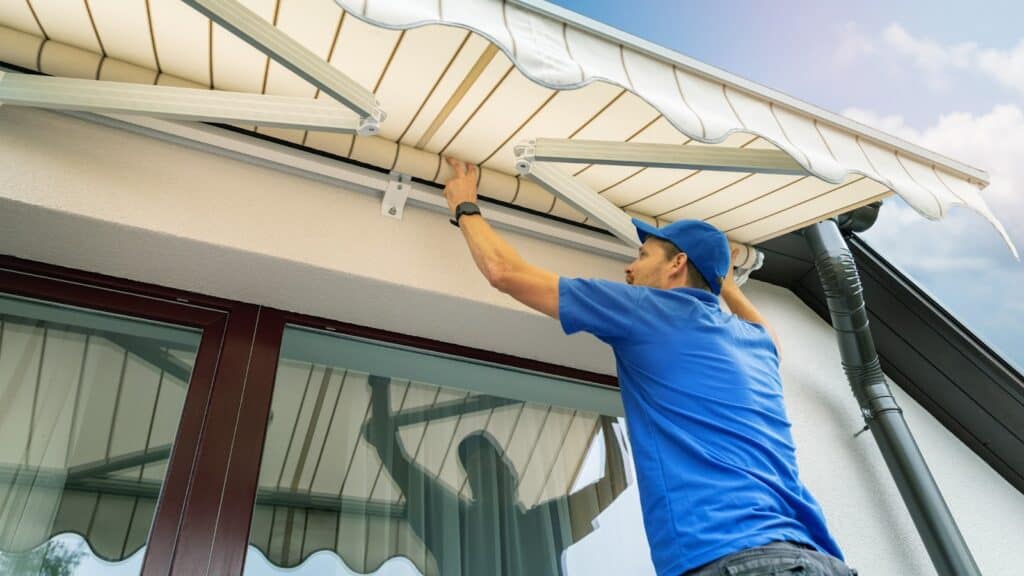
After washing, keep the awning extended until it is 100% dry, and do not roll it up. This prevents moisture from being trapped in the folded fabric, which can lead to mildew growth.
Use A Quality Awning Cleaner
Use a specialty RV awning cleaner like Camco Pro-Strength or Protect All. These specific contain agents to brighten fabric and inhibit mold regrowth. Avoid basic dish soap for the best results.
These steps work for all RV awning types, including acrylic and canvas, whether the awning is manual or automatic.
Clean your RV awning every 1-2 months during heavy-use seasons or at least twice yearly.
DIY RV awning cleaning prevents stains from becoming stubborn and stops mold and mildew growth in their tracks.
Watch the YouTube video below from Kevin and Kim Outdoor Adventures for the step-by-step RV awning cleaning process:
Spot Cleaning Your RV Awning
While a thorough, monthly cleaning is ideal for your RV awning, it’s understandable that a full cleaning isn’t always feasible. If you notice just a few dirty spots on your awning, a quick spot cleaning your RV awning can help freshen it up.
When you spot clean, focus only on the visibly soiled areas instead of cleaning the entire surface. To do this:
- Use a damp rag or sponge to remove or scrub the grime.
- Warm, soapy water usually does the trick for spot cleaning.
- Apply a small amount to the rag and gently rub the soiled patches.
Even though spot cleaning is quicker, you still need to take safety precautions:
- Use a sturdy ladder to reach the awning safely.
- Wear protective eyewear to avoid spraying debris and dirt into your eyes.
- Don’t overextend your reach from the ladder.
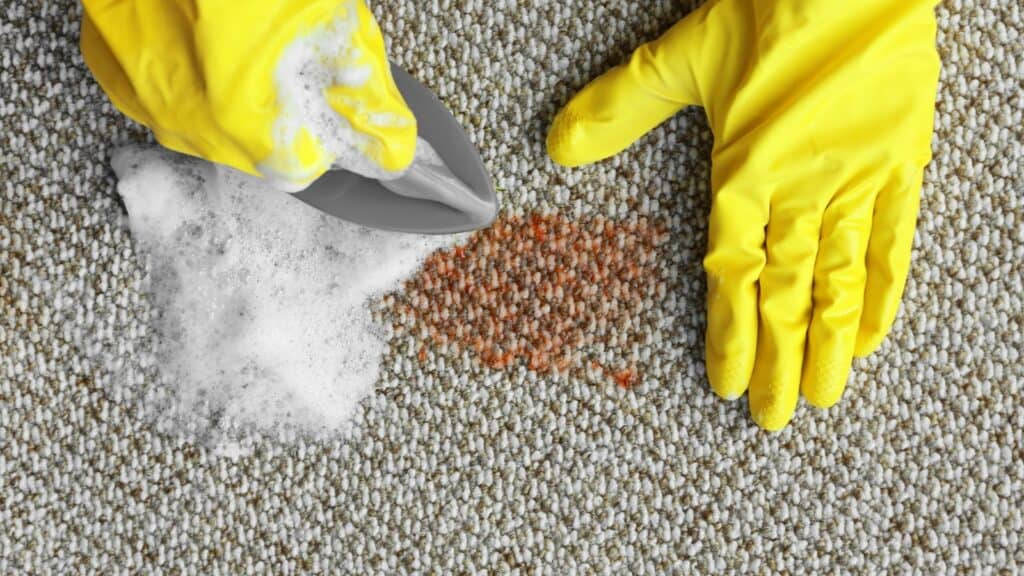
While spot cleaning can tide you over in between deep cleanings, it shouldn’t replace your monthly washdowns. Leftover dirt can gradually spread, and moisture from spot cleaning can pool if you do not rinse the entire awning. Get into the habit of periodic full cleanings for the best results.
Important Don’ts When Cleaning Your RV Awning
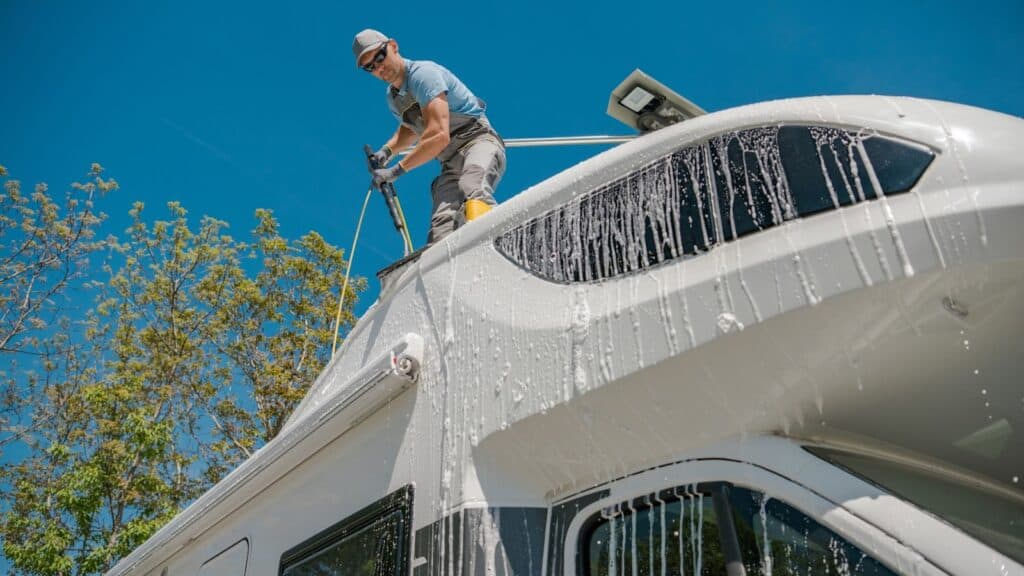
Cleaning an RV awning requires care to avoid damage or safety issues. Here are some key things to avoid when washing your awning:
Putting Excessive Weight On The RV awning
- RV awnings support their own weight and withstand the weather.
- They are not built to hold the weight of a person standing or leaning on them.
- When cleaning the awning, use a ladder or extension pole to reach areas safely.
- Putting your weight on the fabric can lead to rips, tears, and awning collapse, causing injury.
Scrubbing The Awning Arms And Hardware
- The awning arms and hardware are meant to be outdoors.
- It’s best to keep metal components as dry as possible.
- Wet metal can start to rust if you do not dry it properly after cleaning.
- Instead of scrubbing hardware, just wipe down with a damp rag as needed.
Using Harsh Detergents
- Harsh cleaners like bleach, ammonia, or industrial degreasers can damage awning fabric. They can cause discoloration, fraying, and degradation over time.
- Always use only mild, RV-approved detergents.
Power Washing The Fabric
- Power washing is quicker but involves the risk of harming the fabric.
- The high-pressure water can abrade material and damage stitching.
- Use a regular garden hose in a gentle setting instead.
Scrubbing Aggressively
- Scrub stains lightly with only a soft brush or sponge.
- Avoid firm scouring pads that could grind in grime or fray the fabric.
- Let cleaners sit and dissolve stains rather than using excessive elbow grease.
Cleaning in Direct Sunlight
- Heat causes cleaners to dry out quickly before the cleaners have time to work.
- Clean early or late when UV rays won’t evaporate solutions as fast.
- And rinse thoroughly to avoid baked-on residue.
Rolling Up A Wet Awning
- Always let the awning dry before retracting.
- Otherwise, moisture gets trapped inside, leading to mold, mildew, odors, and leaks.
Assuming Rain Rinses It
- Rain alone won’t remove all cleaner residue, dirt, and contaminants.
- Do a final thorough rinse yourself to finish the job.
Neglecting Prompt Spot Cleaning
- Use stain removers immediately on problem areas like bird droppings.
- Don’t allow stains to set in and become more stubborn to remove later.
Avoiding these mistakes will let you clean your RV awning properly and prevent deterioration, staining, and costly damage.
Tips For Cleaning The RV Awning
After many years of RVing, I’ve cleaned my fair share of awnings. I’ve made plenty of mistakes along the way. But I’ve picked up some great tips on how to clean an RV awning.
| Tips | Explanation |
|---|---|
| Set reminders to clean regularly. | It’s easy to forget cleaning tasks when the awning is out of sight. Set a monthly reminder during the camping season to stay on top of it. How often you clean can vary based on usage, but a monthly cleaning will keep it in good condition. |
| Choose an overcast day. | Cleaning on a sunny day may seem ideal for drying, but the heat causes water to evaporate too quickly. This leaves behind soap residue. Aim for an overcast, cooler day so the water stays on the awning longer, giving the soap time to lift dirt. |
| Wear clothes you don’t mind getting wet. | Cleaning an awning involves splashing water, so wear old clothes you don’t mind getting damp and dirty. You won’t be soaked but should expect to get a little wet. |
| Sweep off loose debris first. | Before applying water, use a broom to brush off any leaves, sticks, or other debris. It’s much easier to sweep off dry debris than try to rinse it off later. This prevents debris from sticking to the wet awning. |
| Increase the soak time for tougher stains. | For stubborn bird droppings, let the awning soak longer before scrubbing. This allows the water time to naturally loosen the particles so they wash off more easily. |
| Warm up the water. | Warm water cleans better than cold water by speeding up the chemical reaction. Leave your hose in the sun to warm the water before filling your bucket. |
| Protect your eyes | Sloshing water and spray can kick up debris and dirt. Wear protective eyewear so you don’t get anything in your eyes. |
Conclusion
Keeping your RV awning looking fresh and clean takes some occasional dedication, but it is worth the effort. By following the tips in this guide, you can safely and effectively wash away dirt, stains, mold, and mildew that accumulate on the fabric.
Taking the time to clean and care for your awning properly will help it withstand the environment better, prevent leaks, and keep your RV looking great for many more miles. Read more about RV awnings here.
FAQs
Here are the answers to some of the Frequently Asked Questions about cleaning awnings:
What is the best way to clean an RV awning?
Mixing a simple solution of mild dish soap and water is the safest, most effective method for cleaning RV awnings. You can add a small amount of bleach for disinfecting, but harsh chemicals may harm the fabric. Apply the diluted cleaner with a soft brush, let sit briefly, gently scrub, and rinse thoroughly. You can also order commercial RV awning cleaners for safety, peace of mind, and convenience.
How often should I clean my RV awning?
Wash your RV awning every month while camping and at least once a year if your RV is unused. You will need to clean it more frequently if your RV stays parked under trees or in rainy, coastal areas, which exposes the awning to more debris and environmental contaminants.
Can I use a power washer to clean my RV awning?
It is better if you use a low-pressure garden hose. You can use power washers to clean RV awnings, but proceed cautiously. Keep the pressure low and the nozzle at least 18 inches back to prevent fabric damage. Also, pre-soak the awning before spraying it off. High-pressure water can harm the material.
Can I use bleach to clean my RV awning?
Bleach is good at removing stains, but it can greatly damage the fabric of your RV awning. It is best to use commercial RV awning cleaning solutions instead of bleach.

